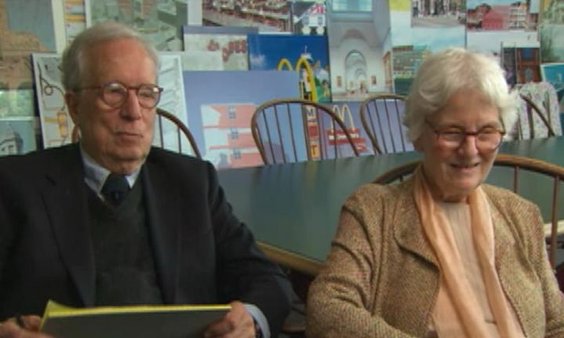[RV] My mother was, and father, were both important to me in many ways, not only as giving birth, having me as a child, but they were just wonderful people. My mother was a – I’ve said that, told this many times – but my mother was the daughter of a poor immigrant Italian family, who could not afford to buy her a winter coat one year when she was in high school, so she had to drop out of high school. But she was continuing… they did… a teacher who loved my mother continued to educate her on the side. Miss Carol, I know her as, who admired my mother, and my mother later became very educated, self-educated. She was a… she became a socialist and voted for Norman Thomas every time he ran, the socialist candidate.
[DSB] That’s why Bob sympathised with the social planners.
[RV] That’s about right, undoubtedly. She was a pacifist and she thereby then became a member, a Quaker, a member of the Society of Friends. I was never sent to a public school, because in those days you had to pledge allegiance to the flag, she thought that was coercive patriotism, so I always went to a private school. But on the other hand, despite all that, she had enormously good taste, she was very interested in dressing well, which usually you don’t think of a socialist woman as going that way. And the furniture that I grew up with… with my mother and father… what they bought when they were married, was just, and is just fabulous furniture… that was… and I very much considered the house, when I designed it, as a setting for the existing furniture that they had, and there are pictures of that to acknowledge the way it was, and I think she was very happy living in the house, I think she was happy with it. My father had died by then, and it soon became a place where lots of young architects came to… or architects came to… visit the place from all over. And she was happy to show them through, and give them a lecture on me as a child, and other things, maybe about socialism.
[DSB] The architecture of the house and the babyhood of its architect.
[RV] God knows. But anyhow, but it was just a… it was a very nice experience to work with that client who was absolutely sympathetic and understanding.
[DSB] Tell them about your father.
[RV] My father, I learned a while back from a historian in Philadelphia who referred to the fruit store designed by Phineas Paste in '99, for Robert Venuri. My father was a fruit merchant, his family came here, he also was born in Italy, but came here. They started a fruit store, and they were poor at the beginning, and in the end he became quite prosperous, and the fruit store became a, not…
[DSB] A wholesale.
[RV] Became wholesale. He produced… you know… delivered fruit to restaurants, to hotels, to universities, to institutions, hospitals. And anyhow, I said, oh, how could that be? In '99 my father was only something like 28 years old, and Phineas Paste would be a very famous and establishment architect, he was one of the architects to design the Belleview Stratford Hotel in Philadelphia. But then I said, ah, he was a friend, and he was… my father was a friend of all the architects in Philadelphia at that time, even though he was… never finished high school and was a fruit merchant.
[DSB] He wanted to be an architect.
[RV] He wanted to be an architect. The building was never built, that he designed for my father, but eventually there was a warehouse designed for my father in 1922, when it was a wholesale business, and that was designed by a well known… a local architect named Edwin Brumbaugh. They both loved architecture, he wanted to be an architect, and they probably influenced me directly and indirectly, but from the very beginning I wanted to be an architect. I can never remember when I did not want to be an architect. I can still drive through streets that were on the way to kindergarten, when I went to kindergarten, and point out my favourite buildings along the way, houses that I… that I liked.






